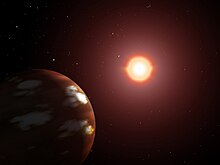Gliese 436
| Observation data Epoch J2000 Equinox J2000 | |
|---|---|
| Constellation | Leo[1] |
| Right ascension | 11h 42m 11.0932s[2] |
| Declination | +26° 42′ 23.653″[2] |
| Apparent magnitude (V) | 10.67[3] |
| Characteristics | |
| Spectral type | M2.5 V[3] |
| Apparent magnitude (B) | ~12.20[4] |
| Apparent magnitude (V) | ~10.68[4] |
| Apparent magnitude (J) | 6.900 ± 0.024[5] |
| Apparent magnitude (H) | 6.319 ± 0.023[5] |
| Apparent magnitude (K) | 6.073 ± 0.016[5] |
| U−B color index | +1.23[6] |
| B−V color index | +1.52[3] |
| Astrometry | |
| Radial velocity (Rv) | +10.0[7] km/s |
| Proper motion (μ) | RA: 895.09±0.03[8] mas/yr Dec.: -813.55±0.02[8] mas/yr |
| Parallax (π) | 102.3014 ± 0.0302[8] mas |
| Distance | 31.882 ± 0.009 ly (9.775 ± 0.003 pc) |
| Absolute magnitude (MV) | 10.63[3] |
| Details[9] | |
| Mass | 0.426+0.027 −0.017 M☉ |
| Radius | 0.415+0.014 −0.010 R☉ |
| Luminosity | 0.025[3] L☉ |
| Surface gravity (log g) | 4.833±0.013 cgs |
| Temperature | 3370+94 −95 K |
| Metallicity [Fe/H] | -0.46+0.31 −0.24 dex |
| Rotation | 39.9±0.8 d[10] |
| Rotational velocity (v sin i) | 1.0[11] km/s |
| Age | 7.41–11.05[12] Gyr |
| Other designations | |
| Database references | |
| SIMBAD | data |
| Extrasolar Planets Encyclopaedia | data |
Gliese 436 is a red dwarf approximately 31.8 light-years (9.7 parsecs) away in the zodiac constellation of Leo. It has an apparent visual magnitude of 10.67,[3] which is much too faint to be seen with the naked eye. However, it can be viewed with even a modest telescope of 2.4 in (6 cm) aperture.[13] In 2004, the existence of an extrasolar planet, Gliese 436b, was verified as orbiting the star. This planet was later discovered to transit its host star.

Properties[]
Gliese 436 is a M2.5V star,[3] which means it is a red dwarf. Stellar models give an estimated size of about 42% of the Sun's radius. The same model predicts that the outer atmosphere has an effective temperature of 3,318 K,[14] giving it the orange-red hue of an M-type star.[15] Small stars such as this generate energy at a low rate, giving it only 2.5% of the Sun's luminosity.[3]
Gliese 436 is older than the Sun by several billion years and it has an abundance of heavy elements (with masses greater than helium-4) less than half%[16] that of the Sun. The projected rotation velocity is 1.0 km/s, and the chromosphere has a low level of magnetic activity.[3] Gliese 436 is a member of the "old-disk population" with velocity components in the galactic coordinate system of U=+44, V=−20 and W=+20 km/s.[3]
Planetary system[]
The star is orbited by one known planet, designated Gliese 436 b. The planet has an orbital period of 2.6 Earth days and transits the star as viewed from Earth. It has a mass of 22.2 Earth masses and is roughly 55,000 km in diameter, giving it a mass and radius similar to the ice giant planets Uranus and Neptune in the Solar System. In general, Doppler spectroscopy measurements do not measure the true mass of the planet, but instead measure the product m sin i, where m is the true mass and i is the inclination of the orbit (the angle between the line-of-sight and the normal to the planet's orbital plane), a quantity that is generally unknown. However, for Gliese 436 b, the transits enable the determination of the inclination, as they show that the planet's orbital plane is very nearly in the line of sight (i.e. that the inclination is close to 90 degrees). Hence the mass quoted is the actual mass. The planet is thought to be largely composed of hot ices with an outer envelope of hydrogen and helium, and is termed a "hot Neptune".[17]
| Companion (in order from star) |
Mass | Semimajor axis (AU) |
Orbital period (days) |
Eccentricity | Inclination | Radius |
|---|---|---|---|---|---|---|
| b | 21.36+0.20 −0.21 M |